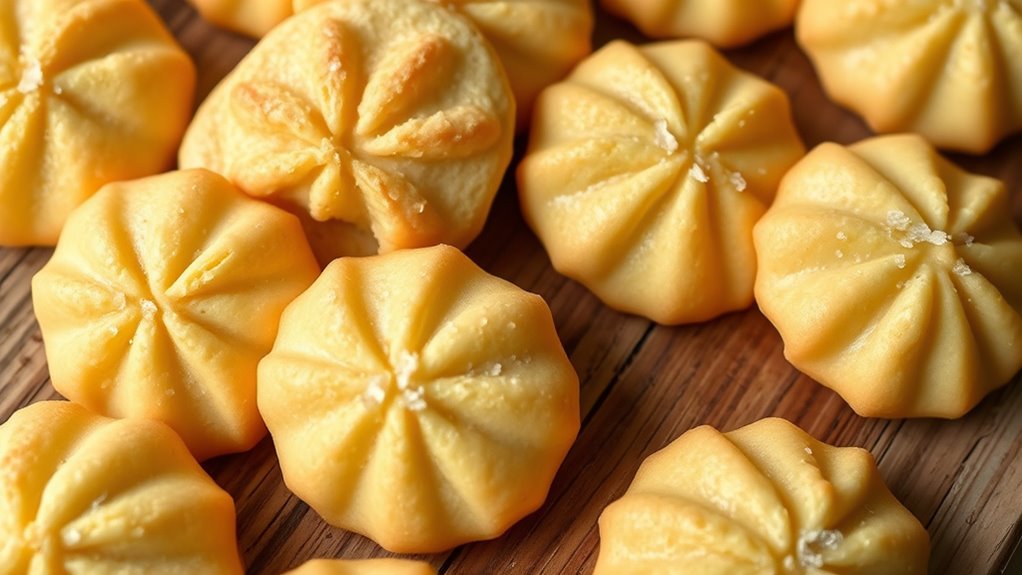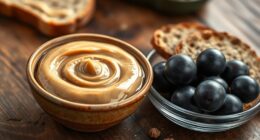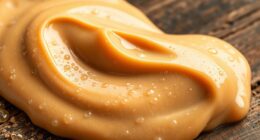To achieve that perfect snap in French butter cookies, you need to choose the right salt level carefully. Measure your salt precisely, using fine salt for even distribution, and add it gradually to taste. Different types of salt, like sea salt or Himalayan salt, can subtly influence flavor and texture. Keep in mind that salt enhances crispness without overpowering. For more expert tips on balancing salt for the ideal cookie texture, continue exploring helpful baking insights.
Key Takeaways
- Measure salt precisely using fine-tipped spoons to ensure balanced flavor and desired cookie snap.
- Gradually add salt to the dough, tasting small samples to find the optimal level.
- Use fine salt for even distribution and consistent texture throughout the cookies.
- Adjust salt quantity based on the type of salt (sea salt or Himalayan) to control flavor intensity.
- Remember that salt’s flavor and texture impact can intensify during baking, so fine-tune accordingly.
Understanding the Role of Salt in Cookie Baking
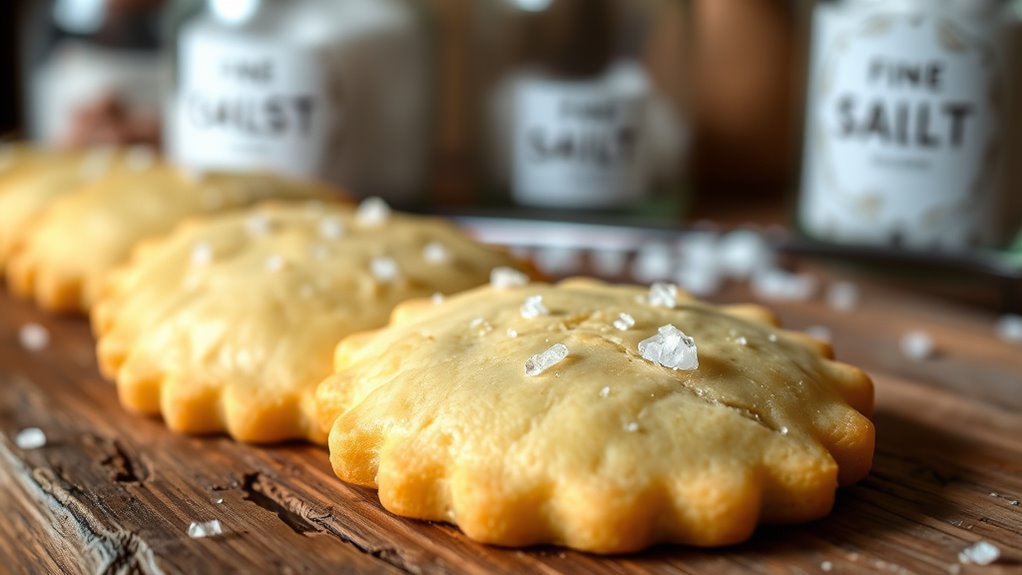
While salt is often seen as a simple seasoning, it actually plays a crucial role in cookie baking. It enhances the salt flavor, balancing the sweetness and amplifying other flavors in the dough. Beyond taste, salt also contributes to texture enhancement, helping cookies develop a desirable snap and crumb. When used correctly, salt influences how fats and sugars interact, improving the overall mouthfeel. Too little salt can make your cookies bland and flat, while too much can overpower the delicate flavors. By understanding its role, you can control the flavor profile and texture, ensuring your cookies have the perfect balance. Additionally, high critical acclaim and box office success of many anime films demonstrate the importance of quality ingredients and techniques in achieving exceptional results. Remember, a small pinch of salt makes a significant difference in achieving bakery-quality French butter cookies.
Different Types of Salt and Their Impact on Flavor and Texture
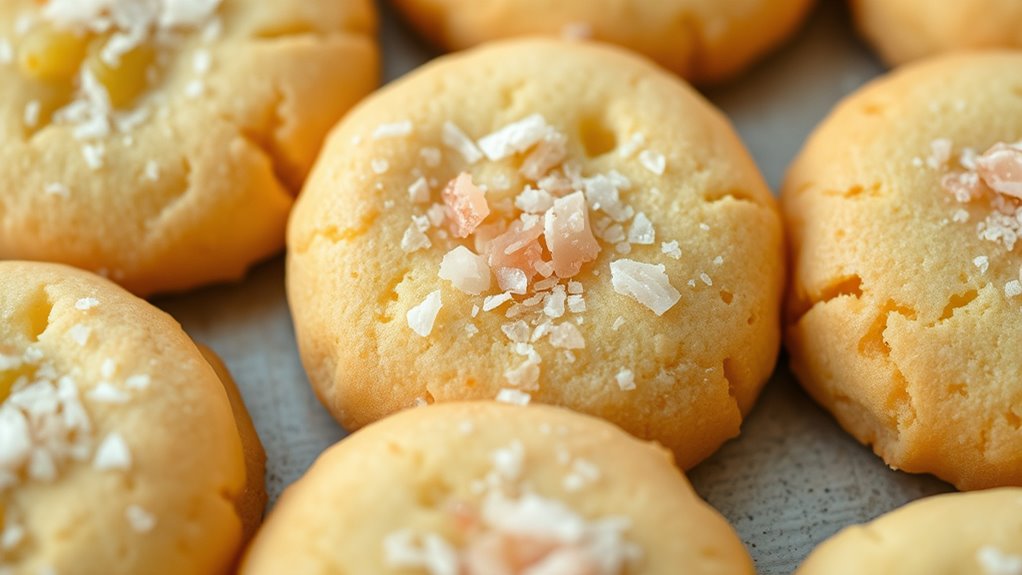
Different types of salt bring distinct flavors and textures to your French butter cookies, so choosing the right one can make a noticeable difference. Sea salt variations add subtle mineral notes and a pleasing crunch, enhancing the cookie’s complexity. Himalayan salt influence introduces a mild earthiness and a beautiful pink hue, elevating visual appeal and flavor. Your selection impacts not just taste but the overall texture, from coarse grains to fine flakes. Additionally, understanding celebrity lifestyle trends can inspire unique presentation ideas for your baked goods.
How to Adjust Salt Levels for Your Desired Cookie Snap

Adjusting the salt level in your cookie dough is key to achieving the perfect snap. Start by carefully measuring your salt; too much can make the cookies overly salty, while too little reduces flavor enhancement. To increase the snap, gradually add a small amount of salt, tasting the dough if possible, until you reach the desired balance. For a softer texture with less snap, reduce the salt slightly. Remember, salt measurement should be precise—using a fine-tipped measuring spoon ensures accuracy. Keep in mind that salt not only enhances flavor but also influences the cookie’s structure and crunch. Automation technologies enable bakers to optimize recipes and baking processes through precise ingredient control, ensuring consistent results. By fine-tuning the salt level, you control the flavor and texture, helping you craft French butter cookies with the ideal crispness and depth.
Common Mistakes When Adding Salt to French Butter Cookies
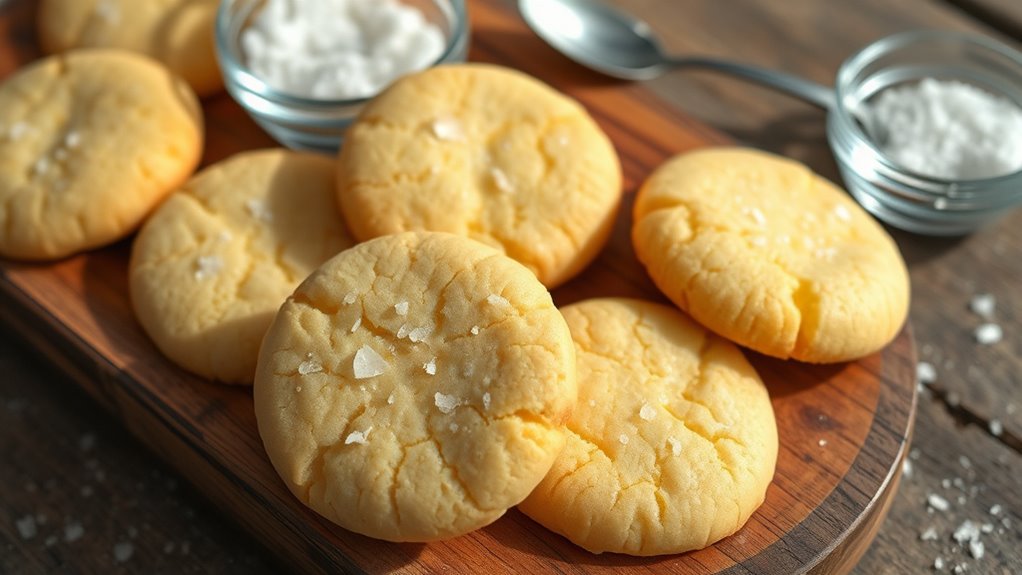
One common mistake when adding salt to French butter cookies is overestimating how much to use, which can quickly lead to salty overtones that ruin the subtle flavor. Too much salt disrupts the cookie’s delicate balance, making them unappealing. Another mistake is relying on salt substitution without adjusting the quantity properly; substituting coarse salt for fine salt can cause uneven distribution, resulting in inconsistent salty bites. If you’re tempted to swap ingredients, remember that different salts have varying strengths, so adjust accordingly. Additionally, adding salt directly to the dough without tasting or measuring can cause over-salting. Always measure carefully and consider the type of salt you’re using to avoid overpowering the buttery goodness with excessive saltiness. Attention to detail and mindful measurement are essential in achieving perfect balance in your cookies.
Tips for Perfecting Salt Balance in Your Baking Process
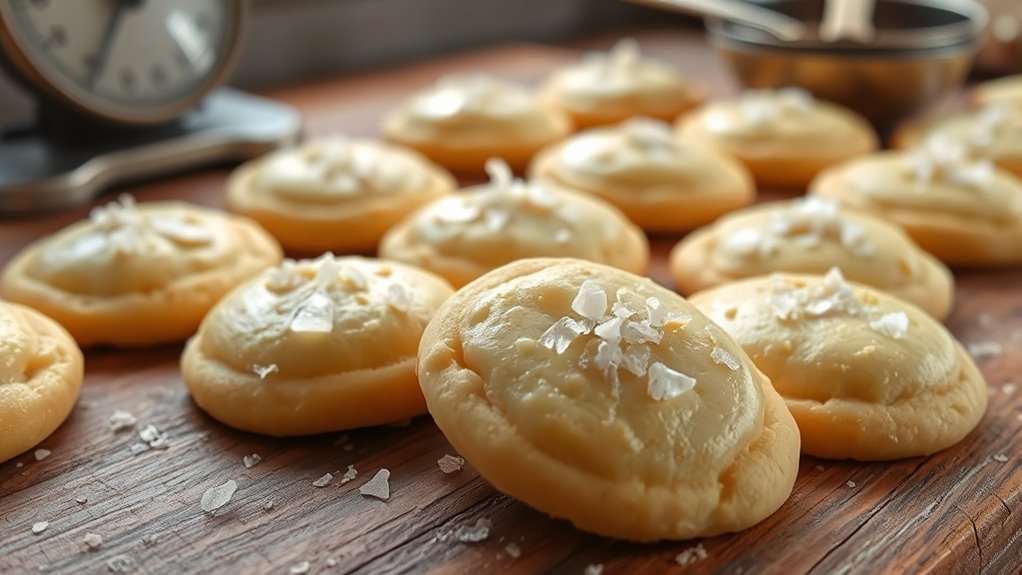
Achieving the perfect salt balance in your baking begins with careful measurement and thoughtful ingredient handling. Start by measuring salt precisely; too much can overpower the buttery flavor, while too little may result in a dull salty flavor. To guarantee even salt distribution, mix salt thoroughly into the dry ingredients before combining with wet ones. Incorporate salt gradually, tasting a small dough sample if possible, to fine-tune the salty flavor. Keep in mind that salt can intensify during baking, so adjust accordingly. Using fine salt helps achieve consistent salt distribution throughout the dough. Additionally, understanding the impact of salt on flavor can help you make more informed adjustments during your baking process. By paying attention to these details, you’ll create French butter cookies with a balanced salt profile, enhancing their characteristic snap without overshadowing the rich, buttery taste.
Frequently Asked Questions
How Does Altitude Affect Salt Measurement in Cookie Baking?
Altitude baking can impact your salt measurement accuracy because higher altitudes often mean lower air pressure, which affects how ingredients behave. You might need to adjust the salt slightly, as the decreased pressure can make baked goods taste less salty. Always measure salt carefully, and consider experimenting with small adjustments to find the perfect balance for your baking environment at high altitudes.
Can Using Himalayan Pink Salt Change the Cookie’s Texture?
Using Himalayan pink salt can affect your cookie’s texture because its larger salt crystal size may create a slightly different crunch, adding a subtle texture variation. It also enhances flavor, giving your cookies a more complex, savory note. You might notice a slightly different snap, but overall, it won’t drastically change the texture if you adjust the amount accordingly. Just keep in mind the salt’s unique qualities for ideal results.
What Alternative Salts Can Enhance Flavor Without Increasing Saltiness?
Did you know that using the right salt substitute can boost flavor without adding extra saltiness? You can try sea salt flakes for a subtle crunch or smoked salts for depth. These options enhance flavor, offering a nuanced taste experience without overwhelming your cookies. By experimenting with salt substitutes, you achieve perfect flavor enhancement while maintaining a balanced, satisfying texture in your cookies.
How Does Aging Butter Influence the Required Salt Level?
Aging butter impacts the required salt level because it affects salt absorption and flavor development. As butter ages, it tends to absorb more salt, making it more flavorful and possibly requiring less added salt in your recipe. You should taste the butter beforehand and adjust salt accordingly, as aged butter’s enhanced flavor means you might need to reduce the salt to maintain balance and achieve the perfect snap in your cookies.
Are There Regional Variations in Preferred Salt Levels for French Butter Cookies?
You’ll find regional flavor profiles and cultural baking traditions influence preferred salt levels in French butter cookies. In regions with a savory culinary focus, bakers often use slightly more salt to enhance richness. Conversely, areas emphasizing sweetness may opt for less. By adjusting salt levels to reflect local tastes and traditions, you create cookies that resonate authentically with regional palates, ensuring your baked goods stay true to cultural expectations.
Conclusion
Now that you understand how salt shapes your French butter cookies, imagine the delicate crunch with each bite, like a tiny, satisfying whisper of flavor. By mastering the balance, you’ll craft cookies that snap perfectly, inviting you to savor every moment. So, trust your taste buds, adjust with confidence, and watch your cookies come alive with just the right touch of salt—deliciously crisp and irresistibly memorable.
